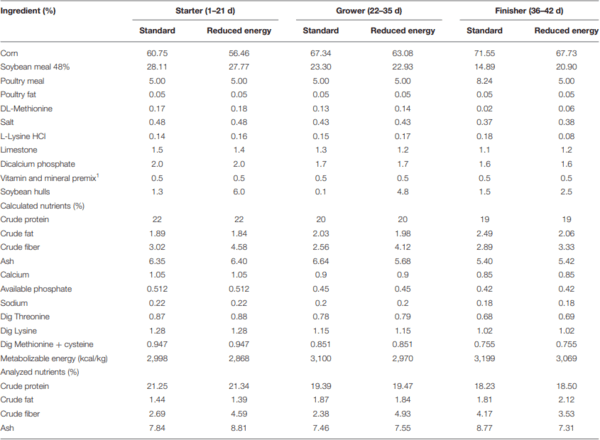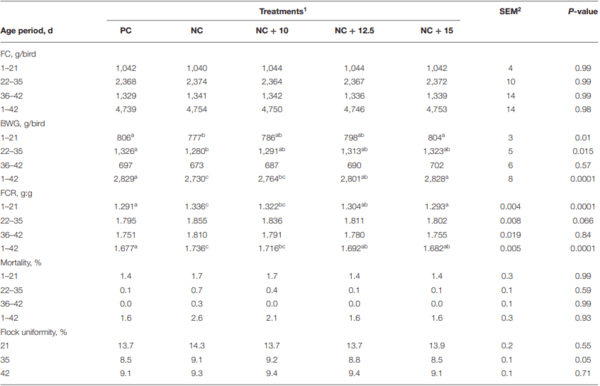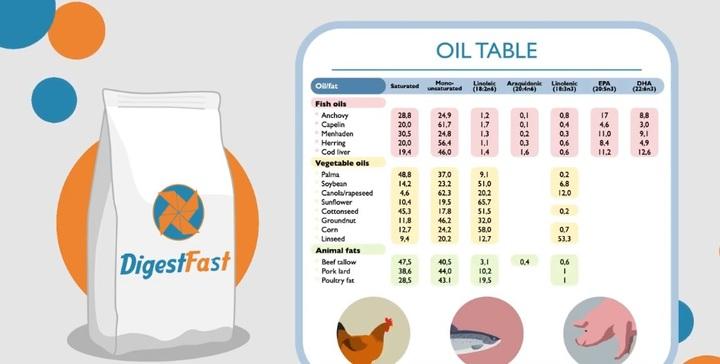The Effect of a Modified GH11 Xylanase on Live Performance, Gut Health, and Clostridium perfringens Excretion of Broilers Fed Corn-Soy Diets





1. Wills RBH, Kerry B, Morgan M. Herbal products: active constituents, mode of action and quality control. Nutr Res Rev. (2000) 13:47–77. doi: 10.1079/0954422001087 29007
2. Choct M, Annison G. Anti-nutritive effect of wheat pentosans in broiler chickens: roles of viscosity and gut microflora. Br Poult Sci. (1992) 33:821– 34. doi: 10.1080/00071669208417524
3. Choct M, Hughes RJ, Trimble RP, Angkanaporn K, Annison G. Nonstarch polysaccharide-degrading enzymes increase the performance of broiler chickens fed wheat of low apparent metabolizable energy. J Nutr. (1995) 125:485–92.
4. Dibner JJ, Richards JD. The digestive system: challenges and opportunities. J Appl Poult Res. (2004) 13:86–93. doi: 10.1093/japr/13.1.86
5. Saleh AA, Gálik B, Arpášová H, Capcarová M, Kalafová A, Šimko M, Jurácek M, et al. Synergistic effect of feeding Aspergillus Awamori and ˇ Lactic acid bacteria on performance, egg traits, egg yolk cholesterol and fatty acid profile in laying hens. Ital J Anim Sci. (2017) 16:132– 9. doi: 10.1080/1828051X.2016.1269300
6. Classen HL. Cereal grain starch and exogenous enzymes in poultry diets. Anim Feed Sci Technol. (1996) 62:21–7. doi: 10.1016/S0377-8401(96)01002-4
7. Classen HL, Scott TA, Irish GG, Huck P, Swift M, Bedford MR. The relationship of chemical and physical measurements to the apparent metabolisable energy (AME) of wheat when fed to broiler chickens with and without a wheat enzyme source. In: Proceedings of the Second European Symposium on Feed Enzymes. (1995). p. 65–9.
8. Scott TA, Silversides FG, Classen HL, Swift ML, Bedford MR, Hall JW. A broiler chick bioassay for measuring the feeding value of wheat and barley in complete diets. Poult Sci. (1998) 77:449–55. doi: 10.1093/ps/77.3.449
9. Scott TA, Silversides FG, Classen HL, Swift ML, Bedford MR. Effect of cultivar and environment on the feeding value of western canadian wheat and barley samples with and without enzyme supplementation. Can J Anim Sci. (1998) 78:649–56. doi: 10.4141/A98-046
10. Kiarie E, Romero LF, Nyachot CM. The role of added feed enzymes in promoting gut health in swine and poultry. Nutr Res Rev. (2013) 26:71– 88. doi: 10.1017/S0954422413000048
11. Bach Knudsen KE. Fiber and nonstarch polysaccharide content and variation in common crops used in broiler diets. Poult Sci. (2014) 93:2380– 93. doi: 10.3382/ps.2014-03902
12. Choct M. Feed non-starch polysaccharides for monogastric animals: classification and function. Anim Prod Sci. (2015) 55:1360–6. doi: 10.1071/AN15276
13. Bach Knudsen KE. Carbohydrate and lignin contents of plant materials used in animal feeding. Anim Feed Sci Tech. (1997) 67:319–38. doi: 10.1016/S0377-8401(97)00009-6
14. Biely P, Singh S, Puchart V. Towards enzymatic breakdown of complex plant xylan structures: state of the art. Biotech Adv. (2016) 34:1260– 74. doi: 10.1016/j.biotechadv.2016.09.001
15. Snelders J, Olaerts H, Dornez E, van de Wiele T, Aura A-M, Vanhaecke L, et al. Structural features and feruloylation modulate the fermentability and evolution of antioxidant properties of arabinoxylooligosaccharides during in vitro fermentation by human gut derived microbiota. J Funct Foods. (2014) 10:1–12. doi: 10.1016/j.jff.2014.05.011
16. Cho JH, Kim IH. Effects of beta mannanase and xylanase supplementation in low energy density diets on performances, nutrient digestibility, blood profiles and meat quality in finishing pigs. Vet Adv. (2013) 8:622– 30. doi: 10.3923/ajava.2013.622.630
17. Nusairat B, Wang JJ. Xylanase and direct-fed microbials (DFM) potential for improvement of live performance, energy digestibility, and reduction of environmental microbial load of broilers. Front Vet Sci. (2020) 7:1014. doi: 10.3389/fvets.2020.606415
18. Liu D, Guo S, Guo Y. Xylanase supplementation to a wheat-based diet alleviated the intestinal mucosal barrier impairment of broiler chickens challenged by Clostridium perfringens. Avian Pathol. (2012) 41:291– 8. doi: 10.1080/03079457.2012.684089
19. FASS. Guide for the Care and Use of Agricultural Animals in Research and Teaching. 4th ed. Champaign, IL: American Dairy Science Association; The American Society of Animal Science; the Poultry Science Association (2020).
20. NRC. Nutrient Requirements of Poultry. 9th ed. Washington, DC: National Academies Press (1994).
21. Aviagen. Ross Broiler Nutrition Specifications. (2019) Available online at: https://en.aviagen.com/assets/Tech_Center/Ross_Broiler/ RossBroilerNutritionSpecs2019-EN.pdf (accessed November 1, 2021).
22. Dahiya JP, Hoehler D, Wilkie DC, Van Kessel AG, Drew MD. Dietary glycine concentration affects intestinal Clostridium perfringens and lactobacilli populations in broiler chickens. Poult Sci. (2005) 84:1875–85. doi: 10.1093/ps/84.12.1875
23. Liu WH, Kim IH. Effects of dietary xylanase supplementation on performance and functional digestive parameters in broilers fed wheat-based diets. Poult Sci. (2017) 96:566–73. doi: 10.3382/ps/pew258
24. Olukosi OA, Bedford MR, Adeola O. Xylanase in diets for growing pigs and broiler chicks. Can J Anim Sci. (2007) 87:227–35. doi: 10.4141/ CJAS06005
25. Saleh AA, Kirrella AA, Abdo SA, Mousa MM, Badwi NA, Ebeid TA, et al. Effects of dietary xylanase and arabinofuranosidase combination on the growth performance, lipid peroxidation, blood constituents, and immune response of broilers fed low-energy diets. Animals. (2019) 9:467. doi: 10.3390/ani9070467
26. Ravn JL, Glits V, Pettersson D, Ducatelle R, van Immerseel F, Pedersen NR. Combined endo-β-1,4-xylanase and α-l-arabinofuranosidase increases butyrate concentration during broiler cecal fermentation of maize glucurono-arabinoxylan. Anim Feed Sci Technol. (2018) 236:159–69. doi: 10.1016/j.anifeedsci.2017.12.012
27. Ward NE. Debranching enzymes in corn/soybean meal–based poultry feeds: a review. Poult Sci. (2021) 100:765–75. doi: 10.1016/j.psj.2020. 10.074
28. Cowieson AJ, Ravindran V. Effect of exogenous enzymes in maize-based diets varying in nutrient density for young broilers: growth performance and digestibility of energy, minerals and amino acids. Br Poult Sci. (2008) 49:37–44. doi: 10.1080/00071660701812989
29. Nusairat B, McNaughton J, Tyus J, Wang JJ. Combination of xylanase and Bacillus direct-fed microbials, as an alternative to antibiotic growth promoters, improves live performance and gut health in subclinical challenged broilers. Int J Poult Sci. (2018) 17:362–6. doi: 10.3923/ijps.2018.362.366
Xylanases: saves costs, improves productivity and flock uniformity.
1. Feed enzyme appli- cation in diets for poultry is also one of the most researched fields in poultry science today, with over 2.500 independent enzyme trials conducted with broilers alone (Rosen, 2010).
2. Energy is usually the most expensive nutritional component of poultry diets.
a) Therefore, a higher efficiency in its utilisation will result in lower feed cost.
b) In the field of nutrition and food technology, the most significant aspects will be the use of enzymes, the evaluation of non-nutritional factors, which may maximise ingredient utilisation by the birds.
3. Feedstuffs should no longer be considered as commodities.
a) Qualitative and nutritional criteria should be used for their purchase and segregation in feed mills.
4. Enzymes will be increasingly used:
a) as they improve ingredient digestibility and nutrient absorption (Cowan et al., 1996),
b) as well as reduce the detrimental effects of anti-nutritional factors, thereby allowing higher flexibility in the use of feedstuffs as well as reducing feed costs (Ferket, 2009)
c) and pollutant excretion in animal waste (Penz-Jr and Bruno, 2010).
d) In addition enzymes lowers feed costs, this will also reduce nitrogen excretion in the environment (Nahm, 2002).
5. Xylanase improves gut health in poultry and is a Energy Booster and has ability to improve digestibility of plant-based feed ingredients and to reduce digesta viscosity is well-accepted.
6. Xylanase appear to be partially related to their indirect impact on mucosal morphology of the small intestine of birds.
a) In the intestine, undigested NSPs, including arabinoxylans, stimulate the proliferation of pathogenic bacteria
b) Xylanase reduces nutrient availability for cecal pathogens
and it not only reduces digesta viscosity through the hydrolysis of soluble arabinoxylans in the small intestine;
7. This process can also improve gut health by generating xylo-oligosaccharides (XOS), which are fermented, particularly in the foregut.
a) These have a prebiotic effect that selectively stimulates the growth of beneficial gram-positive bacteria in the foregut .
b) This greater level of beneficial microbial activity and growth in turn boosts production of volatile fatty acids, which can then be absorbed and utilised by the animal as an energy source.
8. Xylanase reduces oxidative stress in the gut and It reduces mucin secretion. Mucin is an excellent nutrient source for some pathogenic bacteria such as E. coli and Clostridium perfringens.
9. Xylanase significantly reduces wet litter.
a) xylanases can reduce the adverse effects of anti-nutritional factors in feeds, facilitate the development of healthy gut microbiota, and maintain optimal gut function and integrity.
10. Xylanase improves laying performance in layers, Breeders and boosts energy in Broilers.
a) Xylanase improves flock uniformity and also reduces the impact on feedstuff variability.
Dr V. Rajendra Prasad











.jpg&w=3840&q=75)